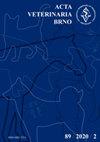Point of care diagnostics and non-invasive sampling strategy: a review on major advances in veterinary diagnostics
IF 0.7
4区 农林科学
Q3 VETERINARY SCIENCES
引用次数: 1
Abstract
The use of point of care diagnostics (POCD) in animal diseases has steadily increased over the years since its introduction. Its potential application to diagnose infectious diseases in remote and resource limited settings have made it an ideal diagnostic in animal disease diagnosis and surveillance. The rapid increase in incidence of emerging infectious diseases requires urgent attention where POCD could be indispensable tools for immediate detection and early warning of a potential pathogen. The advantages of being rapid, easily affordable and the ability to diagnose an infectious disease on spot has driven an intense effort to refine and build on the existing technologies to generate advanced POCD with incremental improvements in analytical performance to diagnose a broad spectrum of animal diseases. The rural communities in developing countries are invariably affected by the burden of infectious animal diseases due to limited access to diagnostics and animal health personnel. Besides, the alarming trend of emerging and transboundary diseases with pathogen spill-overs at livestock-wildlife interfaces has been identified as a threat to the domestic population and wildlife conservation. Under such circumstances, POCD coupled with non-invasive sampling techniques could be successfully deployed at field level without the use of sophisticated laboratory infrastructures. This review illustrates the current and prospective POCD for existing and emerging animal diseases, the status of non-invasive sampling strategies for animal diseases, and the tremendous potential of POCD to uplift the status of global animal health care.护理点诊断和非侵入性采样策略:兽医诊断的主要进展综述
点护理诊断(POCD)在动物疾病中的使用自引入以来已稳步增加。它在偏远和资源有限的环境中诊断传染病的潜在应用使其成为动物疾病诊断和监测的理想诊断方法。新发传染病发病率的迅速增加需要紧急关注,其中POCD可以成为立即发现和早期预警潜在病原体的不可或缺的工具。快速、容易负担得起以及能够现场诊断传染病的优势促使人们努力改进和建立现有技术,以产生先进的POCD,并逐步提高分析性能,以诊断广泛的动物疾病。发展中国家的农村社区由于获得诊断和动物保健人员的机会有限,总是受到动物传染病负担的影响。此外,在畜禽-野生动物交界面出现的新发和跨界疾病及其病原体外溢的惊人趋势已被确定为对国内人口和野生动物保护的威胁。在这种情况下,POCD结合非侵入性采样技术可以在不使用复杂实验室基础设施的情况下在现场成功部署。本文综述了POCD在现有和新出现的动物疾病中的现状和前景,动物疾病无创采样策略的现状,以及POCD在提高全球动物卫生保健地位方面的巨大潜力。
本文章由计算机程序翻译,如有差异,请以英文原文为准。
求助全文
约1分钟内获得全文
求助全文
来源期刊

Acta Veterinaria Brno
农林科学-兽医学
CiteScore
1.00
自引率
33.30%
发文量
36
审稿时长
18-36 weeks
期刊介绍:
ACTA VETERINARIA BRNO is a scientific journal of the University of Veterinary and Pharmaceutical Sciences in Brno, Czech Republic.
The scientific journal Acta Veterinaria Brno is dedicated to the publication of original research findings and clinical observations in veterinary and biomedical sciences. Original scientific research articles reporting new and substantial contribution to veterinary science and original methods that have not been submitted for publication elsewhere are considered for publication. A written statement to this effect should accompany the manuscript, along with approval for publication by the author´s head of department. The authors bear full responsibility for the contents of their contribution. Book reviews are published, too.
 求助内容:
求助内容: 应助结果提醒方式:
应助结果提醒方式:


